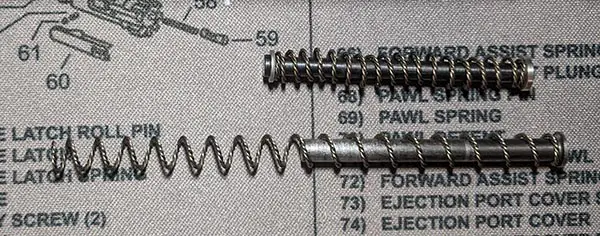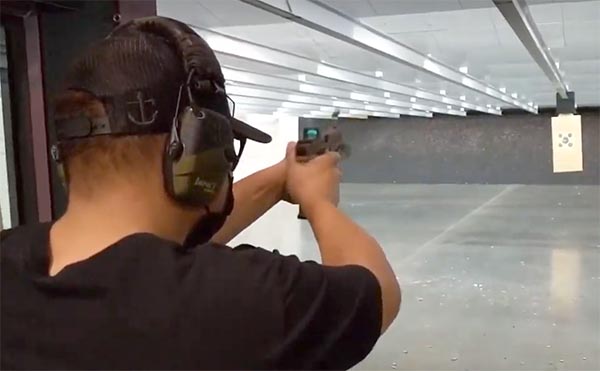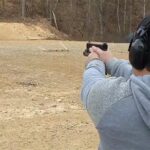Terms like recoil, kick, and kickback are often used as synonyms in the shooting community. Furthermore, consensus about the definition of recoil and kick aren’t universally accepted. As such, you may be wondering “what is recoil on a gun?” or “is there a difference between recoil and kick?” Today I’m going to provide my understanding about what each term means and how they are different. Additionally, I’ll talk about what factors influence recoil, how to mitigate it, and ultimately reduce kick.
Table of Contents
What Is Recoil?
Physics dictates that every action has an equal and opposite reaction. The recoil on a gun is the product of a round being fired and the resulting forces. Therefore, we can think of recoil as the measurement of force being applied to the gun itself.
During combustion — or rather the controlled burn — of smokeless powder, gasses, energy, and other byproducts are generated. This energy is what forces the bullet from the casing, down the bore, and out the muzzle.
Artillery demonstration of recoil
When the bullet goes forward, energy is also transferred backward and into the firearm. This energy will take the path of least resistance, and is the premise for how automatic reloading handguns operate. That energy is used to “cycle” the firearm, sequentially ejecting the spent casing and loading a new cartridge.
Recoil is often described as the backward, or rearward, forces produced when firing a handgun. Force equivalent to what is used to propel the bullet is simultaneously directed rearward thus the term, recoil.
Is There A Difference Between Recoil and Kick?
Opinions vary about whether there is a difference between recoil and kick. However, recoil describes the transference of energy into the components of the gun. Alternatively, some force is transferred to you, the shooter, and is the definition of kick.
Various springs, bolts, and even the frame absorb energy when a bullet is fired. These parts will outright absorb or move to their extremes before looking for other outlets to dispel the force — namely your body.
Kick or kickback – transferring energy from gun to shooter.
Kick, or kickback, is the perceived recoil on a gun. Sometimes this is aptly described as “felt recoil.” Not all recoil energy is passed onto the shooter. Therefore, the difference between recoil and kick can be described as the true resultant energy from firing a bullet (recoil) versus what the shooter feels (kick).
The kick on a gun is what results in muzzle rise. Additionally, muzzle rise can be referred to as muzzle flip, muzzle hop, muzzle jump, and muzzle climb.
Regardless of how you define recoil and kick, there is a correlation between the two. The greater the recoil on a gun, the greater the associated kick. Therefore recoil, kick, and kickback are often used interchangeably.
Methods To Reduce Recoil
If you want to lower the recoil, you really only have a couple options at your disposal. First, you can lower the caliber of the round you are shooting since more force is required to move a heavier and larger object. Therefore, by lowering the size of the bullet you are effectively minimizing the amount of force required to move that projectile.
Second, you can slow the bullets down to minimize recoil. More force is required to fire projectiles at high speeds. Anyone who has experienced a squib load understands this concept. When the bullet never leaves the barrel, there is little to no recoil and no kick whatsoever.
How To Decrease Kick On A Gun
Alright, we’ve covered how to reduce the recoil by modifying the cartridges you shoot. But, how do we reduce the kick on a gun? Ultimately, strategies to reduce recoil will also reduce kickback. But, reducing kick is a bit more complicated as each firearm is unique. However, there are a few different ways to minimize kick.
Compensator or Muzzle Break To Reduce Felt Recoil
First on the list of ways to decrease the recoil a shooter feels is to add a compensator or muzzle break. Gas pressure builds inside the firearm when firing a bullet. To mitigate the impact on the shooter, a compensator helps to disperse these gasses. Instead of this energy being transferred through the gun, it is instead directed outward. An example of this can be found on the above animations where the gasses are being directed outward from the muzzle.
Beef Up Your Recoil Spring To Reduce Kick

Another way to reduce the kick from your handgun is to swap out your recoil spring for a more stout version. Making the recoil spring more difficult to compress means it will soak up more energy and ultimately lead to less felt recoil. Length, wire thickness, and number of coils affect a springs compression strength.
Reduce Felt Recoil With A Heavier Handgun
Just like a heavier bullet requires more energy to move, a heavier handgun will transfer less force to the shooter. Unfortunately, you can’t really increase the weight of your current handgun. However, you can opt for steel or other metal frame over polymer frame guns. Additionally, full-size handguns tend to weight more than their compact and subcompact counterparts.
Parting Shots
Unfortunately there is no magic way to eliminate recoil on a handgun. All you can do is hope to reduce both recoil and kick. Hopefully this article has explained the difference between recoil and kick. Additionally, now you understand why the two are not mutually exclusive in normal discussion. If you found this article helpful, please like, share, or leave a comment. Thanks for stopping by!









